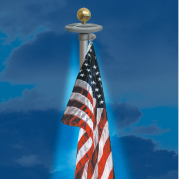The Continental Colors Flag
Although unofficial, the Continental Colors flag

is considered to be the first American flag. It was used from 1775-1777, preceding the Betsy Ross flag Betsy Ross flag and aiding in its design. The Continental Colors includes a field of 13 alternating red and white stripes with a British Union Jack in the canton.
Records show that Philadelphia seamstress Margaret Manny sewed the first Continental Colors for the Alfred, and in December of 1775, the flag was raised for the first time on any fighting vessel. A year later, the flag was considered the official flag of the American naval forces by the Maritime Committee of the Continental Congress.
On New Year’s Day in 1776, George Washington ordered the Continental Colors to be raised on Prospect Hill in Somerville, Massachusetts in celebration of the birth of the Continental Army. Although many flags protesting British rule were in existence at that time, including those with icons of snakes, pine trees and the word "liberty", Washington choose to use the Continental Colors. It was hoisted on a 76 foot flagpole and could be seen all the way in Boston. Washington referred to the flag as the "Union Flag in Compliment to the United Colonies." It was also known as the Grand Union flag, the Union flag, the Continental flag, the Somerville flag and the Great Union.
The flag’s designer is unknown, but it is speculated that Benjamin Franklin, Thomas Lynch and Benjamin Harrison were responsible. They were appointed by Continental Congress to advise George Washington in creating the Continental Army in 1775. It is also possible that Washington himself or one of his staff members designed the flag.
On the other side of the world the East India Company had used a strikingly similar flag since 1701. The flag contained between nine and 13 red and white stripes with a red Cross of St. George on a white field in the canton. Most flag experts dismiss the similarity, calling it coincidence since there is no record that the East India Company flag flew in American waters and few colonists were familiar with it.
While the Continental Colors is symbolic, the exact meaning of its design is uncertain. It is generally believed that the stripes, like those of the Betsy Ross flag, represent the 13 colonies, while the Union Jack in the canton was meant to show colonial loyalty to the crown or to traditional British values and laws. Since the flag was supposed to express the colonies’ desire for independence from Britain, the use of the Union Jack seems slightly contradictory and would prove to be a mistake. When British troops noticed the Continental Colors in Boston, they interpreted the use of the Union Jack as a sign of surrender.
By June 14 1777, the Continental Colors was replaced by the first Stars and Stripes. The canton was changed from the British Union Jack to a blue field with thirteen white stars, representing a "new constellation" and America’s new found independence.
References Flag: An American Biography by Marc Leepson 2004.



















